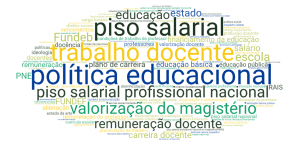ORIGINAL ARTICLE
COIMBRA, Walnier Rodrigues [1], VALERIO, Elry Cristine Nickel [2]
COIMBRA, Walnier Rodrigues. VALERIO, Elry Cristine Nickel. Games and play in elementary school in the municipal network of Belo Horizonte. Revista Científica Multidisciplinar Núcleo do Conhecimento. Year. 07, Ed. 03, Vol. 01, p. 47-86. March 2022. ISSN: 2448-0959, Access link: https://www.nucleodoconhecimento.com.br/education/games-and-play, DOI: 10.32749/nucleodoconhecimento.com.br/education/games-and-play
ABSTRACT
Currently, it is clear that school-age children do not show interest in old games and play, it is observed that they are being stimulated and led to the use of new technologies and electronics. The guiding question of this study is: do teachers use traditional games and play in the classroom and what is their opinion on the subject? It aimed to identify the opinion of teachers in relation to Games and play in the integral development of students from the 1st to the 5th year of elementary school in the city of Belo Horizonte – MG. A descriptive field research was carried out with a qualitative and quantitative approach, applying a semi-structured questionnaire, in a sample of 100 teachers. In the theoretical framework, research related to child development was sought: motor, affective, cognitive and social aspects, in addition to games and play in the school context and the dynamics of classes proposed by teachers, used in the past, highlighting the perceptions of learning by playing and play learning in elementary school, with the mediation of games and play in the classroom. The study shows that there is unanimity among the teachers interviewed in the sense of understanding and using traditional games and play as part of the teaching-learning pedagogical process. Realizing the need for technical updating of professionals for the implementation and application of recreational activities in the pedagogical format. Although they know the importance of games and play for the development of students, it was noticed that interventions, direct in schools, are still restrained. Respondents stated that the greatest benefits are related to group interaction, reasoning ability and concentration, partially confirming the hypothesis of this study. There is a need for a broader understanding of the practice of games and play, covering aspects of development and integrality, generating in teachers more pedagogical intentionality in planning the practice. Therefore, recognizing the benefits, conformity and uniformity within educational institutions, so that games and playare seen, not only as a recreation tool, but as an act of learning, an inexhaustible source of pleasure, joy and satisfaction.
Keywords: Games, play, Students, Development, Elementary School.
1. INTRODUCTION
The present work presents a discussion and understanding of games and play for the integral development of students from the 1st to the 5th year of elementary school in municipal schools in Belo Horizonte – MG. In view of the above, the guiding question of this study arises: do teachers use traditional games and play in the classroom and what is their opinion on the subject?
It can be seen in the experience as an educator that nowadays children, at infant age, do not show interest in games and play that produce integral development. It is observed that the current generation of children is being stimulated and led to the use of technologies, which are often exaggerated, disconnects children from the real world, preventing experiences, skills and opportunities that would promote the integral development of the child carried out through games and playful games (SILVA, 2017).
Child development is an essential part for the development of the human being, a peculiar process of each child presented by the sequences and changes of skills and abilities throughout life (BRASIL, 2013).
The General National Curriculum Guidelines for Basic Education (BRASIL, 2013) cites the primary experiences of childhood in learning, the bond and stimuli received by parents and school are fundamental for the child’s brain development and greatly affect the expansion of cognitive, social, affective, emotional and motor in the future.
According to Santos; Quintão; Almeida (2010) children in general go through a process of progressive development with foreshadowed advances. These social, cognitive, affective, emotional, motor, language and communication characteristics are considered from the developmental milestones that are references used to analyze and monitor the parameters of child growth. It is worth mentioning that the developmental milestones are not a rule but a guideline, as each child has their peculiarities, their maturation and development time, which must be respected, so that they can grow in time and space and develop an action in the world.
The child’s world is based on some areas of development, which are: motor development, social development, cognitive development and emotional development. These domains need to be tuned and developed in a harmonious way, so that one area does not predominate over another, therefore, in early childhood education children will have the opportunity to learn, to deal with rules and new challenges, to build autonomy, to deal with frustrations, build new learning and knowledge, know how to share, develop skills and motor skills and be a protagonist of their history (DUARTE; BATISTA, 2015).
According to Fantacholi (2011) games and play are seen as a pedagogical resource in contemporary times and are seen as one of the most powerful tools for the integral development of children in early childhood education and that promotes learning in different knowledge, making it possible to develop their independence, autonomy, solving their daily issues, actively participating in problem solving, acquiring knowledge for the most diverse areas, establishing bonds, defining their role and identity.
Therefore, the research looked for possible correlations between authors with regard to games and how they can be effective in integral development. In this sense, it is essential to carry out studies that investigate the relationship between games and play experienced in the past, with the contribution they generate in elementary school children.
The research population consisted of teachers from the municipal school system in the city of Belo Horizonte who work with elementary education from the 1st to the 5th year and who are active in their positions, of both sexes and with unfixed ages and experience, the general objective of the research was to identify the opinion of the professors in relation to the Games and Jokes in the integral development of the students. Based on this assumption, the specific objectives are: to analyze, evaluate, identify and describe the games and play experienced in the past so that children can go through an evolutionary process, manifesting physical, intellectual, social, psychological, pedagogical and affective development, in addition to the lasting effects brought about by the experience.
The preliminary form of access to the sampling elements for the development of field research was based on the relationship network of the researcher who works in the area and has several contacts within the institutions, a place where references were sought to add a relevant number of professors to the study.
It is expected that through the information obtained in this study, professionals in the Education area who work directly with the children in question can adapt, qualify and develop strategies for implementation and experience within the teaching units.
The theoretical model of this study and its relevance should pave the way for new research in the area of Education Science, as it allows to identify and analyze the main aspects for the integral development of the child through games and play and it is expected to attract attention to the theme and contribute to the discovery of new hypotheses and ways that can fully develop the child in all physical, intellectual, social, psychological, pedagogical and affective aspects.
In addition, the conclusions can serve as a basis for other research relevant to the subject addressed.
2. METHODOLOGY
This chapter of the article demonstrates the methodological processes and possibilities of paths taken in the course of the research verification.
As for the means, this study is classified as bibliographic research and field research. The research is bibliographic because during the construction of the theoretical and methodological framework, material already prepared was used, among the most used are books and scientific articles, all the material consulted in the study of the bibliographic research is public and available for research, such as: articles, theses, dissertations, monographs, newsletters, database, in addition to research in books, magazines, newspapers and periodicals. Therefore, through this study material, it integrates the knowledge on the topic in question (GIL, 1999).
In the understanding of Lakatos and Marconi (2003), the universe or population of the research refers to the grouping of animated or inanimate subjects who identify themselves by having at least one attribute or particularity in common. That in this study was composed of elementary school teachers, who work with children from the 1st to the 5th grade in the age group between 06 and 10 years old, represented in their respective schools of the municipal network of the city of Belo Horizonte that corresponds in the year 2021 , to the number of 3227 teachers according to data from the Municipal Department of Education (MINAS GERAIS, 2022).
To carry out the research, a pre-test was carried out, that is, the pilot questionnaire following the recommendations of Gil (2008) the pre-test is carried out through the application of some questionnaires (between 10 and 20) the selected population must be the that will be identified in the definitive search.
The pilot questionnaire is in turn a data collection device that seeks to detect possible difficulties, precision and ensure validity and accuracy. Gil (2008) mentions that for the questionnaire to be effective and well-prepared, it must have: “a) clarity and precision of terms; b) form of questions; c) breakdown of issues; d) order of questions; e) introduction of the questionnaire” (GIL, 2008, p. 134).
Following Gil’s (2002) recommendations, the pilot questionnaire was applied to 10 selected individuals who were part of the population of interest. Before sending the questionnaire itself, telephone contact was made with those selected, where they were discussed how their participation would be. After the first contact, the questionnaire was sent via email and within 1 (one) week, the 10 respondents returned the questionnaires with their respective reservations, analyses, criticisms and considerations.
After the adjustments through the pre-test, an effective questionnaire was applied to teachers who work in Elementary School from the 1st to the 5th year of municipal schools in the city of Belo Horizonte that are working effectively.
For this study, forms were created and used for field research. Based on studies by Lakatos and Marconi (2003), field research is characterized by enabling the researcher to obtain information and knowledge related to the problem, in which an answer is sought, or a hypothesis in which one wants to prove something, or even discover other phenomena. or connections between them.
The technique chosen for investigation was the form, as it provides greater reach, that is, reaching many individuals, even if they are in an extensive geographic space, due to the ease of sending the form via email and WhatsApp, thus ensuring a relevant sample for the investigation. the study. Another aspect to consider is that the research form does not require personnel expenses, as the questionnaire does not require preparation and training of the researchers.
The questionnaire and form were applied from October 8, 2021 to November 2, 2021. And the tabulation with data analysis was carried out from: November 2 to December 10, 2021.
The forms applied did not require the identification of the respondents, therefore ensuring the anonymity of the questions answered. Another relevant aspect that the respondent can answer at any time, does not require that the answers be given at the time they receive them, so the respondents can respond at the appropriate time. It is worth mentioning that through the research forms sent via email and WhatsApp, the individuals participating in the study do not receive influence or personal opinions from the researcher, thus maintaining a more credible and reliable research.
The questionnaire had a total of 21 (twenty-one) questions, 17 (seventeen) of which were objective with response options ranging from 4 to 5 defined answers and 4 (four) discursive (open) questions. In closed questions, research participants are asked to choose one of the alternatives presented. The questionnaire was applied through the Google Forms tool, where emails were sent to all elementary education institutions in the municipal network of the city of Belo Horizonte – MG, with the population that was part of the research universe. Contacts with the respective schools were established in advance, along with a letter of introduction and explanation of the project. In addition to electronic mail, the questionnaire was sent via WhatsApp, Facebook, Twitter and Instagram, that is, it was contemplated and made available on several social networks.
The objective questions, according to Gil (2008), are the questions commonly used in most researches, due to the great uniformity of the data obtained through the answers and for being easier to ascertain and process at the time of tabulation and discussion analysis. The 4 (four) discursive questions had questions relevant to the subject in question and following the line of Gil (2008), respondents were asked to be honest and put their own answers. The open (discursive) questions allow and allow ample freedom of response to the respondents of the questionnaire.
The data were tabulated through a field research and based on the methodology referenced in the study where they were analyzed and presented. The information was analyzed through the establishment of percentages of the answers cited in order to allow an interpretation of the research results. This work was carried out through the electronic tabulation of the data, through Google Forms itself where the survey questionnaire was built, the tabulation of the data occurs as the surveys were being processed by the operating system and it already calculated the data, leaving it stored and organized.
Another resource used was to associate Excel with Google Forms so that they share the same data sheet, thus facilitating the transfer of graphics and data for the use of the body and the development of the methodological work, in addition to being archived and stored in a that can be used and applied when required in other phases of the study. After the electronic tabulation of the data made by Google Forms, a thorough analysis of the statistical data was carried out, which were based on authors.
For the data contained in the table with the discursive answers, a manual tabulation was made, which the answers were analyzed and a condensation of similar answers was made. obtained. As this is a broader research, it was necessary to use mixed data tabulation, that is, manual and electronic tabulation was used in the same study. After the identification of the answers, the analysis and discussion of data from the tables with the answers was carried out.
3. RESULTS AND DISCUSSION
It is extremely important to know who the teacher who works in basic education is, in addition to being relevant, the author considers it fundamental, because through the information obtained from the profile and characteristics of teachers, more appropriate training strategies can be traced. Find out about the practices experienced by educators, delve into their work routine, identify their skills and knowledge, transmit bases and resources in which to think about the best ways and intentions to improve education in the general scope so that they can seek to maximize results and quality of education for the population (ANDRÉ, 2009).
The data were obtained through field research and based on the methodology referenced in the study, after tabulating the data and aiming to meet the research objectives.
3.1 QUESTIONNAIRE ANSWERED BY TEACHERS
Graph 1 below shows the percentage of responses related to the question of the use of games and play by the interviewed teachers in their classes as a form of teaching-learning and whether the teacher has already worked or works with this methodology, being observed that 40% of teachers regularly work with games and play activities in their classes. Another portion of the teachers, which corresponds to 36% of those surveyed, work sporadically with games and play in their classes as a way of providing teaching and learning to students from the 1st to the 5th year of elementary school. Another 17% of the educators work assiduously and effectively with the activities of games and play , providing the development of teaching and learning in their classes. The minority, which corresponds to 7%, of the teachers interviewed never worked with recreational activities in order to propose teaching and learning in their elementary school classes. Therefore, through the data obtained, it can be observed that most education professionals use or have used games and play activities as a way to provide their students, from the 1st to the 5th year of the municipal network of Belo Horizonte – MG, with a teaching-learning aimed at the integral development of its students.
According to Piccioni (2007), presenting a proposal for games and play within the school environment means providing the most varied ways of expressing, overflowing, imagining, discovering and experiencing the act of playing in its totality and effectiveness.
Graph 1 – Works developed through games and play in their classes as a form of teaching and learning in Elementary School
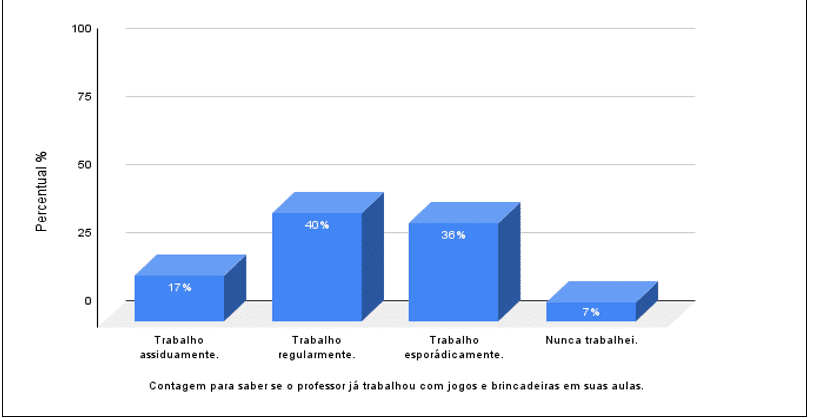
Complete playfulness contributes to the content related to children and adults to become extensive and lasting, allowing them to think, act, decide, cooperate, compete, imagine, build, discover, feel the most diverse emotions, create, accept limits , experience, cooperate and live the charm of childhood life (PICCIONI, 2007). This statement can also be found with Marques et al (2020) emphasizing that play is one of the paths that enable integral development within early childhood education. The procedure and act of playing are extremely important in the teaching-learning system, since it is not just about a period of leisure and fun, it is a period in which knowledge, discernment, perception and training for the next life are manifested (MARQUES et al. ., 2020).
Also seen by Brescovit and Utzig (2016), the rescue of traditional games and play from the past will allow a new look at the integral development of the child, as another culture of play will be observed, another way of life, expression, imagination and creativity. Through old games and play , children will be able to renounce in part the dependence on electronic games and toys and thus have a healthier and healthier life, factors that are the aim of parents and educators, that is, that their children have more quality of life in every way.
According to the data presented in Graph 2, below, it can be seen that 54% of teachers use traditional games and play nowadays for the integral development of their students. Still checking the data, it is noted that 19% of teachers prefer and prioritize board games as a way of developing their students and 13% of teachers interviewed use digital games to provide the integral development of their students. It is also observed that 9% of educators do not use any type of game or play. And 5% of the teachers interviewed prefer to allow the children in the class to take their games and toys to be used in the classes, with the teacher being only the moderator of the activities.
Graph 2 – Games and play used nowadays for the development of students:
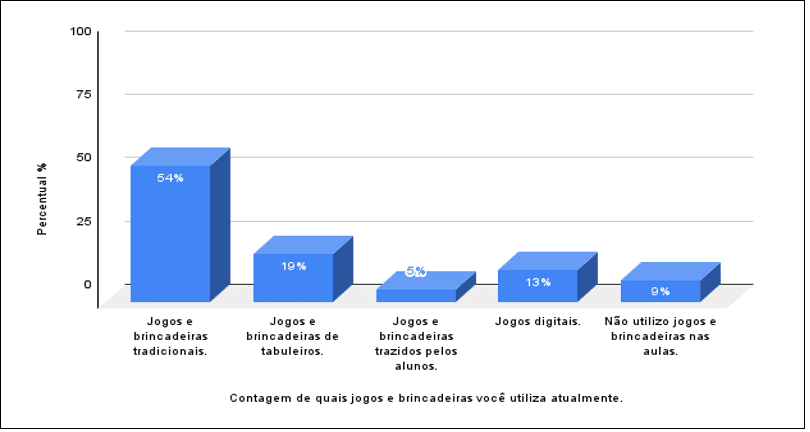
Marques (2017) cites that playing and playing are extremely important in everyday life within educational institutions, because through activities it becomes the most pleasant and healthy environment, providing unique moments of pleasure and learning, therefore. , it is up to teachers to generate a critical reflection on games and play within the classroom, and the teacher in turn needs to have access to this knowledge, providing the use of play as a form of teaching and learning for their students. This knowledge must be stimulated and learned from the initial training of the teacher, thus providing the necessary conditions for the use of this instrument as a facilitator and stimulator of teaching and learning.
For Piccioni (2007) Traditional games and play also represent an inexhaustible source of historical knowledge about the universe and about each individual, thus contributing to the integral development of students, through cognitive resources that favor and awaken reasoning, decision making, problem solving and historical-critical questioning of their reality.
Rodrigues, Santana and Santos (2016) clarify that games are an important pedagogical resource for modern times, because through their systematic practice children will be guided and stimulated to the principle of motor, psychological, social, affective, cognitive development. and school learning. The practice of games and play, mainly in the school context and without hesitation, is one of the best tools for learning, for experiences, experimentation and transformations, in addition to assisting in socialization, understanding, autonomy and growth.
According to the study carried out and the research in question, in graph 3, it is found that 56% of teachers, that is, most emphasize that traditional games and play, from the past, have a relevant contribution in their classes. Part of the teachers, corresponding to 38%, use traditional games and play in their classes in the same way and believe that the child learns through play and plays by learning, thus uniting knowledge with play. Another 6% of the teachers interviewed also believe in traditional games and play, they use this strategy because they understand that it facilitates learning and enables quality learning. In the answers obtained, it was found that none (0%) of the teachers considers that there is no relevant contribution in the use of games and play in their classes.
In the studies by Piccioni (2007) he considers the memory of playing, which is currently missing due to the great exaggeration of accessories and modern materials offered to children, however, it is believed that traditional games and play with an educational nature can still be rescued through of a connection between the educator and the student, also strengthening the links between their peers and the culture. It is observed that through this junction that the games and play persisted in time and space and will always have a place of connection of the child with his imaginary universe full of fantasies and discoveries.
Graph 3- Contribution of games and play in classe
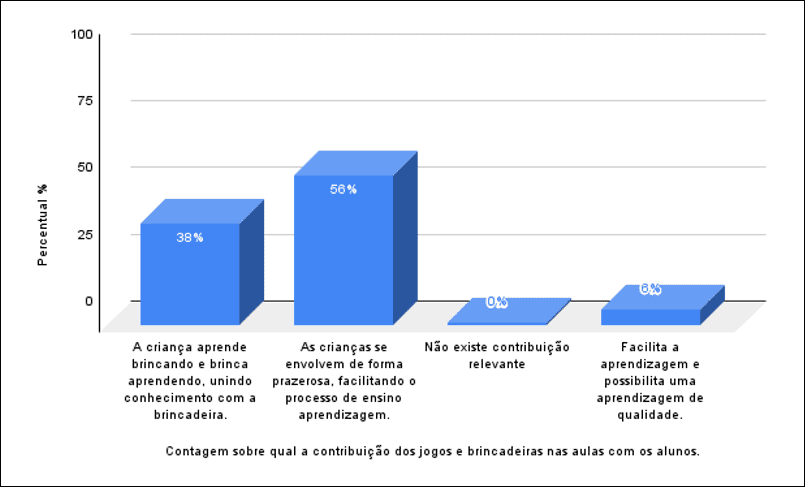
Just like Rodrigues; Santana and Santos (2016), Teixeira (2014) corroborates that the school spaces of educational institutions must be attractive, organized, large, dynamic, clean, easily accessible and multipurpose, a place where the practice of games and activities is favorable and explored. can serve for children to develop their skills, creativity and imaginations.
Teixeira (2014) informs that several activities collaborate as a pedagogical resource of contemporaneity, among them highlights the activities of games through the arts and educational games that relate body care. The author also exposes the importance of “having rooms suitable for the ages of the students, having varied pedagogical resources, employees, such as qualified teachers who present coherent pedagogical plans” (TEIXEIRA, 2014, p. 81).
In the data obtained through Graph 4, below, it was found that most elementary school teachers understand that traditional games and play have an ideal dynamic for the development of their students in various aspects, such as cognitive, affective, social development. and engine, therefore, 54% consider traditional games as the best form of integral development. Another 24% of the teachers surveyed consider modern games as the best dynamic and ideal for the integral development of their students. Another 11% of teachers consider that digital games are one of the best ways to provide ideal dynamics for playing games. For 10% of teachers think that the responsibility for games and play should be on behalf of Physical Education teachers, therefore, exempts such responsibility. And only 1% show that games are rarely used in their daily activities in the classroom.
Graph 4 – Ideal dynamics for playing games
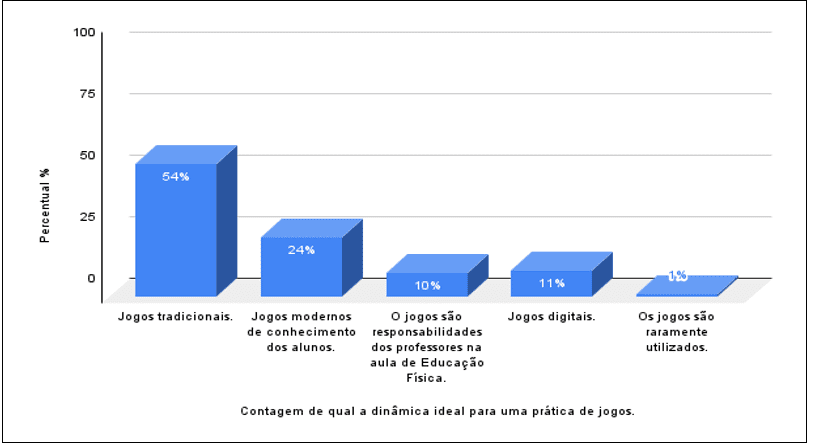
For Silva (2004) alleges that the universe of fascination of many children who do not have access to games and toys technologically built to a niche market, however, there is a current that creates and recreates the children’s world of games and play from the traditional games from the past that in turn go beyond barriers and often pass from generation to generation, always considering the imaginary, fantasy, make-believe, discovery and the universe of playing and being happy, therefore, this dream of the maker account and fantasy have historically perpetuated through time and space to act an action in the world.
The author Silva criticizes futuristic electronic games, when he emphasizes in his narration that the act of playing develops and moves the countless experiences in the sociocultural context, which in turn is considered fundamental for the child to be able to see and better understand the world around him. return. In this aspect, it should be considered that the electronic games and toys of post-modernity overshadow the creativity, imagination, fantasy and discovery of human life (SILVA, 2004).
According to the data obtained through field research, referring to the spaces and environments suitable for the development of games and play activities in schools, it can be seen in graph 5 (below) that 49% of the schools in the municipal education networks of the Belo Horizonte have spaces and environments suitable for the practice and development of games and activities. Other schools that correspond to 40% have some spaces for the development of activities, however, they are not so adequate. Another 7% of schools have only classroom spaces for the development of activities, not having appropriate spaces such as: courts, living areas, garden, fields and recreational spaces. With 4% is the minority of schools that in turn do not have adequate spaces for the development of activities and possibly also the classrooms are not conducive to the practice of games and play for pedagogical purposes.
According to Navarro and Prodocimo (2012) school spaces and environments must be built and adapted for and with children, having perception and discernment of their needs, difficulties, desires, attractions and involvement of the environment so that it becomes an appropriate place. so that the child can develop in time and act through an action in the world. For the author, it is very relevant to think about the numerous possibilities of mediation of recreational activities in the educational institution.
Levando em consideração que brincar não é apenas necessidade, mas direito das crianças, acreditamos que as instituições de educação infantil devem estar organizadas de acordo com as características das crianças e devem valorizar a brincadeira em seus espaços e tempos (NAVARRO; PRODÓCIMO, 2012, p. 634).
Graph 5 – Appropriate spaces and environments for the development of games and activities in schools:
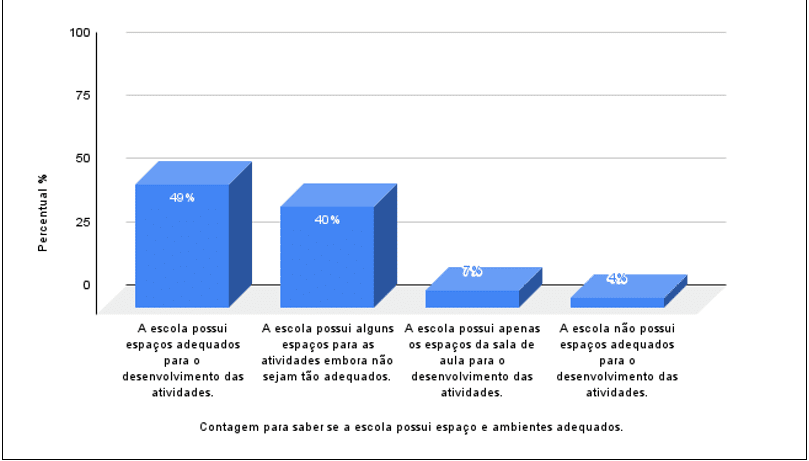
According to Fantin (2000), the rescue of past games and play act as connections for the present, to make a difference in the future. The act of playing and rescuing such activities allow children to experience unique practices that were a milestone in the lives of many children who lived in the 80s and left evidence that such games and play will make a difference in the lives of children in kindergarten who live in nowadays, as it has become known throughout history that the traditional games practiced in the mid-1980s had a great influence on the integral development of the motor, social, affective and cognitive aspects of children at that time.
For Fantin (2000) it is very important to rescue the games of the past, because such games express history and culture and as the activities could help in the development of the child in early childhood education, the rescue of traditional games and play will reveal singularities of life, reflexive behaviors, experiences, forms and meanings, especially ways of playing and relating. Producing the existence of traditional activities from past decades to the present to make a difference in the future, confirms Fantin (2000).
Kishimoto (2001) also describes that the rescue of traditional games that occurred in childhood decades ago is to rescue the history and culture of a people, although this popular culture is undergoing many changes in the social and technological sphere, the school in turn it is also part of this process of change and transition.
For Rodrigues, Santana and Santos (2016) the educational institution provides the right environment for the traditional games of the past to be rescued, the experience through play that children find a new world, full of novelties and discoveries. Kishimoto (2001) completes by saying that the act of playing is presented as a tool capable of effectively acting in the integral development of children in early childhood education, corresponding to the desires arising from their universe and thus building their particularities and identity.
Navarro and Prodocimo (2012) emphasize that closed spaces, organized rooms with tables and chairs, locked toy cabinets and accessories, somehow inhibit the child’s desire to play. Therefore, the educator and the entire school committee must have a holistic view, that is, see and be attentive to the provision of accessories and play materials in the classrooms.
It is noted in graph 6 in relation to the experience and effective participation of the teacher with traditional games and play in their childhood, that most of the interviewees stated that they participated effectively and that the activities were part of their childhood, which corresponds to 70 %, as regular participation in traditional games, the survey showed 20% of the teachers who had regular contact with the activities, and 10% of the interviewees rarely participated in the activities of games and play, interesting that all the teachers in the sample had already had some contact with the traditional games and games, therefore, we had no response (0%) as they never participated in traditional games and play.
Discussing Graph 6 Fardin (2015) mentions that several experiences of rescuing old games and games proved to be very positive, as they help in the learning process, and such activities can be interpreted only as resources, and losing the meaning of games, or in some situations, even the ludic sense, taking other forms and functions in the training and systematization of knowledge, since they are used with the main function of achieving already established results.
Graph 6 – Experiences of traditional games and play in the teacher’s childhood:
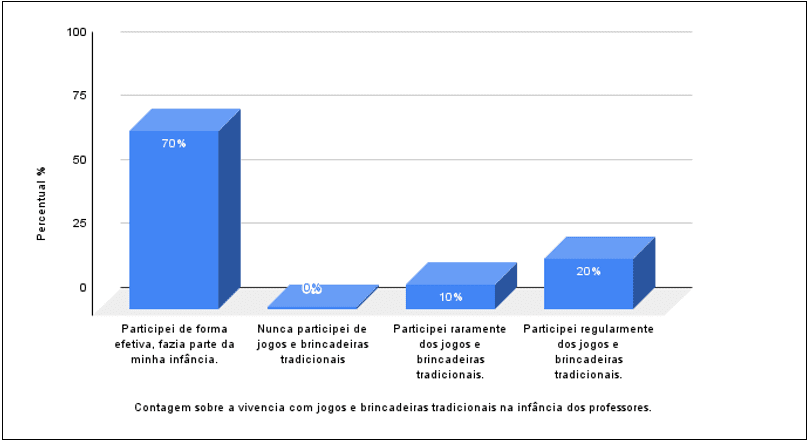
Fardin (2015) cites a similar study on old games and play, noting in his sample that the majority also used the activities and experiences of games as an integral part of their daily routine and less than half answered that they had no contact and did not do it. play and toys are part of their daily lives, therefore, it indicates that a small part of the interviewees just did not have the experience in their childhood with the activities of games and toys, thus being very close to the records found in graph 6, which represents 0-10% of participants.
Play works as a fundamental element for the growth of children as a whole, in addition to being a pleasurable, integrative activity that provides socialization with other children from different cultures. Physical Education classes with a focus on autonomy and training or on games awaken children to new sources of interest, development of creativity and especially for a more effective learning, therefore, traditional games and play can be seen as a strong pedagogical resource for contemporary classes (SANTOS, 2012).
A very close percentage was diagnosed in Graph 7 below, which deals with the development of games and play activities with the pedagogical purpose in classes, that is, 36% have already developed activities in their classes with the purpose of pedagogical development, and 35% regularly develop games and play in their classes with the aim of pedagogical development in some taught subject. For 24% of the interviewed teachers, they also develop activities, but without regularity, that is, when possible they are developed. Another data corresponds to teachers who never developed activities in their classes with the purpose of pedagogical development, that is, 5% of the interviewees said they never worked with games and play in a targeted way, with the aim of educational development.
It is satisfactorily observed through Graph 7, where it was found that most teachers are aware of the importance of activities for pedagogical development and regularly develop traditional games and play in their classes, thus seeking the integral development of elementary school students. from the 1st to the 5th year of the municipal network of the city of Belo Horizonte – MG.
Graph 7 – Development of activities of games and play with pedagogical purpose in classes:
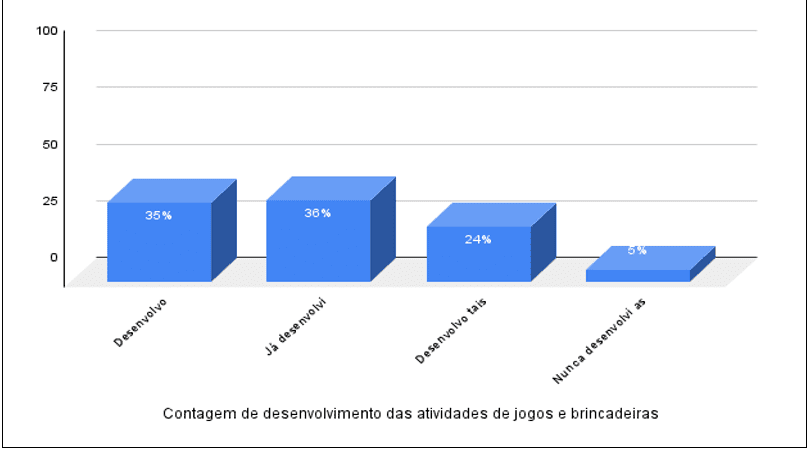
Playing works as a fundamental element for the growth, autonomy and formation of children as a whole, in addition to being a pleasurable, integrative activity that provides socialization with other children from different cultures. Physical Education classes with a focus on games awaken children to new sources of interest, development of creativity and especially for a more effective learning, therefore, traditional games and play can be seen as a strong pedagogical resource for contemporary classes ( RODRIGUES; SANTANA; SANTOS, 2016).
Ribas (2012) also corroborates that nowadays the world is fully inserted in globalization and high technology in the most diverse segments of society and in the education of children is no different, all this technology ends up leading children to individualism, that is, it totally opposes to collectivism, diminish the ability to develop group activities, to create, to adapt, to imagine and to experience all forms of playing, interacting and being happy.
For Neves (2012) traditional games and play have undergone numerous changes in their format and application, the changes have occurred due to several factors, among them the shrinking of spaces that were intended for the practice of activities, many of them were decreased due to the growth of violence that occurred in large metropolitan centers, another reason that was predominant for the reduction of leisure, recreation and development of games and play that was also mentioned by other authors such as: Ribas (2012), Rodrigues; Santana and Santos (2016), Teixeira (2014), Brescovit and Utzig (2016), Brustolin (2012) and Alves et al. (2015), to the spread of the electronic children’s games and toys industry, which in turn are increasingly flashy, engaging and seductive, leading children to surrender to their charms and possibilities.
Fardin (2015) also questioned teachers in his research on toys and old games and found in his investigation about the use of toys and games as a form of pedagogical development, and arrived at the following data: 83% of teachers effectively use toys and old games as a form of pedagogical development in their classes and 17% of the teachers stated that they do not use such activities for the purpose of pedagogical development in their class activities. Therefore, it is noted in both studies an approximation in percentage regarding the use of traditional games and play as a form of pedagogical development in their classes in the municipal network from the 1st to the 5th year of elementary school.
According to the data obtained, in graph 8, below, on the opinions of teachers in relation to the games and play of the past, if they are still practiced with elementary school students today. Unfortunately, the following percentages were found in the survey, 55% claim that games and play activities are rarely practiced in their classes today. Another 22% demonstrate that games and play activities are currently practiced with some regularity, however, it appears that it is still a very small number due to the size of the sample. A part that corresponds to 18% of those surveyed declare that the activities of games and play are not currently practiced in their classes. And 5% of the research participants declared that the activities are practiced regularly and effectively in their classes. This last data shows the importance of rescuing traditional games and play for the present day and the relevance of being an integral part of the classes in an effective way.
Graph 8 – Opinions regarding the games and play of the past if they are still practiced with elementary school students today
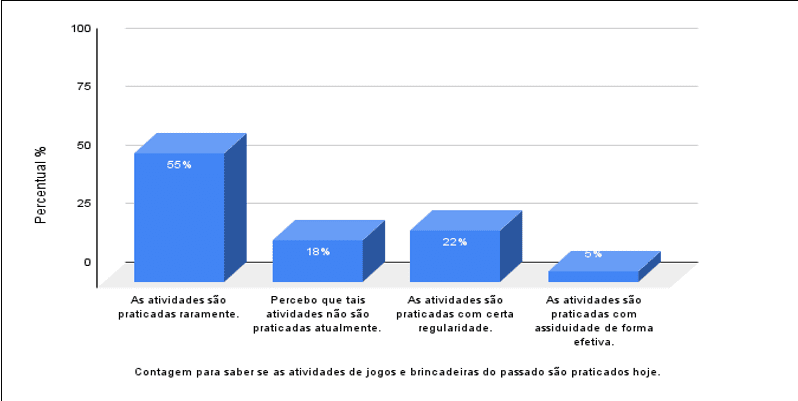
Souza (2008) mentions that:
… na tentativa de associar tais saberes, o movimento de profissionalização docente vem trazendo à tona a valorização da prática como momento de construção de conhecimentos e novos saberes, que emergem do próprio trabalho, a fim de formar o professor como profissional possuidor de saberes específicos, os quais mudam com o tempo e devem ser passivos de avaliação (SOUZA, 2008, p. 55).
Cordazzo and Vieira (2007) discuss revealing that educators must value and respect games and understand their influence on the integral formation of children, teachers are references for stimulation and development of the skills and abilities of their students, in addition to participating directly in the instigation creativity, imagination and research. The educator will represent the agent of transformation, through his holistic view, that is, seeing his students as a whole, allowing their spontaneity and multiple experiences through play and games.
Alves (2001) apud Cordazzo and Vieira (2007) approach the discussion in an elementary way and notes that, “A good teacher is not the one who gives a perfect class, explaining the subject. A good teacher is one who transforms the subject into a toy and seduces the student to play” (ALVES, 2001, p. 20-21).
Still in this sense, Silva (2004) shows that it is necessary to understand the singularities and characteristics that occur in the construction of the performance of playing. Silva (2004) emphasizes that the traditional games and play of the past enjoyed by parents and family members in the 80s, bring experiences from the past to the present day.
Regarding the accessories and materials that schools have for the development of games and play activities in classes from the 1st to the 5th year of elementary school in the municipal network of the city of Belo Horizonte, it can be seen in graph 9, below, that fortunately 50% of schools have a good number of materials for the development of practical activities. On the other hand, 40% of schools have few accessories and materials to be used in class. Unfortunately, only 5% of schools have many accessories and materials for the development of classes with a pedagogical purpose. And 5% of the sample of schools surveyed do not have any type of accessory and/or material that can be used for the development of students.
Graph 9 – Accessories and materials that schools have for the development of games and play activities in class
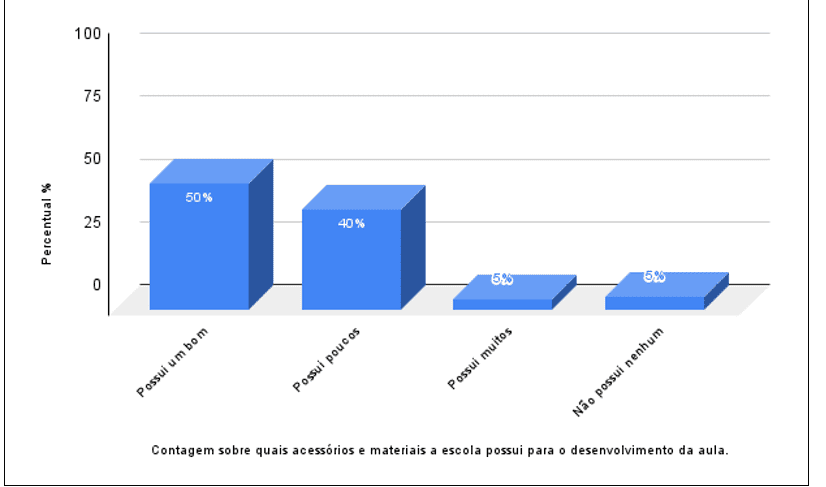
According to Navarro and Prodocimo (2012), students’ learning and development are the result of the act of playing, investigating and experimenting with games and activities with a pedagogical purpose. The teacher, in turn, must be the mediator, encourager and agent that can provide discoveries, transformations and experiments in children’s lives. The authors cite that:
A qualidade do brincar não depende apenas da professora, mas a forma como a mediação acontece pode fazer grande diferença. A escola também pode ajudar nessa questão, por exemplo, adquirindo brinquedos adequados para a idade das crianças, ou pensando dentro da estrutura física da escola em ambientes dedicados ao brincar, com mais espaço e brinquedos diferentes, ou até dentro da rotina, em horários em que turmas diferentes se encontrem e possam brincar juntas. Tudo isso faz parte da mediação do brincar feita pela escola (NAVARRO; PRODOCIMO, 2012, p. 646).
In summary, Marques (2017) verifies that games and play enable innovations in the ways children learn and develop, related to aspects such as: qualification of the teaching staff, preparation of the school space, acquisition of accessories and materials used for practice, adequacy of the environment school and parents’ awareness, therefore, through these adaptations and insertions, an improvement in education processes can be expected, competent to satisfy the primary desires of children, since games and play within the school context are not added, but are part of the integral learning and development methodology.
The child’s development begins with the discernment of his own body, that is, knowing the body culture, individuality and specificities, since through the structuring of the body that the person generates connections with the materials and individuals that constitute his daily coexistence. (DAOLIO, 1995).
According to the data collected and inserted in Graph 10, below, it can be seen that 75% of the professionals surveyed consider that games and play can be used as a form of integral development in all subjects taught (Mathematics, Portuguese, Science, History, Physical Education, Geography, English, Art and Informatics). For 10%, they consider that the application of games and play are relevant only in the following subjects: (Mathematics, Portuguese, Science, History, Physical Education, Geography). They present with 7% the educators who verify that the subjects that can be developed in the traditional games and play are: (Mathematics, Portuguese, Sciences, History, Physical Education). Another 7% consider that games and play should be an integral part of the following subjects: (Mathematics, Portuguese, Science, History, Physical Education, Geography, English). And only 1% considers that the activities of games and play are exclusively of the discipline of Physical Education, not considering that the other disciplines taught can be linked and can be worked effectively with the intention of the integral development of the students.
It is clear to Cordazzo and Vieira (2007) that play is one of the main actions for the integral development of early childhood education, in addition to being one of the main practices cultivated and carried out during the child’s growth. Games and play inspire children to develop in several aspects (motor, cognitive, social and affective) in addition to enabling a development in the learning of curricular subjects. Through the games the child is driven to transformations in the child’s psychic development. For many scholars as stated by Cordazzo and Vieira (2007). Play gives access to more eminent patterns in the integral development of the child.
Graph 10 – The subjects that can be worked with traditional games and play
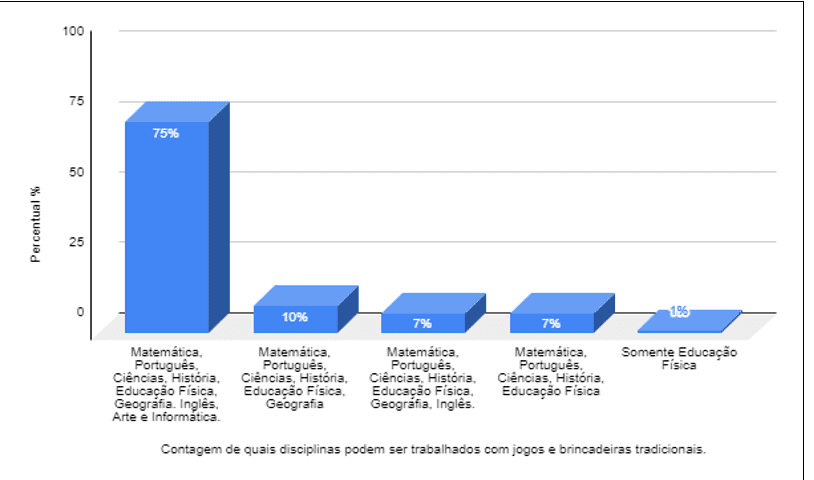
For Piccioni (2007), games are also relevant for the development of children in all its aspects (motor, affective, cognitive and social), in the numerous events of children’s life their participation in expressing and expressing their opinions is significant and effective. , difficulties, experiences, sensitivities and anxieties, in addition to reporting facts, situations and events. It also highlights that the child, through games and play, learns to listen to the other, share and lend toys, create and produce toys and games, feel stimulated to develop their creativity and imagination, in addition to acquiring more independence and making a child more autonomous, with personality forming their identity and their own history of experiences with playing individually and in groups (PICCIONI, 2007).
According to the results obtained, through Table 1 of responses (below), it can be seen that all respondents answered the question, and many responded with more than one answer, therefore, all the respondents’ opinions were considered. Assertives were considered, among the 4 (four) answers that are a consensus among the interviewees, (the lack of pedagogical materials) (The lack of willingness on the part of the teachers to develop the activities) (The lack of adequate space for the development of activities) (The need to train the teaching staff to develop activities). The teachers’ opinions about what is necessary for the practice of games and games as a didactic resource in the classroom reveal, therefore, that they consider that the most necessary to perform games and play as an instrument and didactic resource in the classroom are the teaching materials to carry out the activity. They also consider that the most necessary thing for the practice inside the classroom with pedagogical intention is the pedagogical intention, that is, they inform that many professionals have no interest in developing the activity. Other interviewees relate to the absence or inappropriate spaces for the development of activities proposed for the integral development of students. They also reveal that what is most necessary is the preparation and training of teachers, so that they can understand and effectively apply the activities of games and games in the classroom so that they can be an instrument and didactic resource in the classroom.
Table 1 – Opinions on what is necessary for the practice of games and play as a teaching resource in the classroom for elementary school teachers:
| Teachers’ opinions | Answers |
| Have materials to carry out games and play | 33 |
| Pedagogical intentionality | 29 |
| Have adequate space to carry out activities | 19 |
| The training of professionals so that they can exercise | 19 |
| Have creativity on the part of teachers | 14 |
Source: Prepared by the author (2021).
Rodrigues; Santana and Santos (2016) clarify that games are an important pedagogical resource for modern times, because through their systematic practice children will be guided and stimulated to the principle of motor, psychological, social, affective, cognitive and cognitive development. school learning. The practice of games and play, mainly in the school context and without hesitation, is one of the best tools for learning, for experiences, experiments and transformations, in addition to helping in socialization, understanding, autonomy and growth. The author adds that through childhood games and play, students find a favorable environment to develop their skills, creativity, dramatic representations, imaginations, motor skills, reaction time, creative and logical reasoning.
The professor and researcher at USP, Tizuko Morchida Kishimoto (2001) carried out several studies and researches related to the theme of play and games. Some of her work and research concerns the importance of stability and maintenance of collective memory regarding the practice of games and play, in addition to historical origins, child development through activities, therefore, the researcher investigates the importance of rescuing games and play carried out in past decades to the present day, identifying their pedagogical relevance for the integral development of the child. (SILVA, 2004).
Os brinquedos e brincadeiras de nosso passado histórico, transformavam-nos em seres capacitados ao fluxo sociabilizante. Muitas vezes, através das brincadeiras coletivas, entendíamos as regras sociais como a discriminação, os grupos dominantes e os dominados, o namoro, o casamento e suas regras morais, o que é certo ou errado, enfim, instrumentalizávamos nosso conhecimento sobre o mundo e, nos dias atuais a tecno-massificação impossibilita a coletivização e constrói o fantasmagórico mundo da individualização (SILVA, 2004, p. 17).
Table 2, below, was structured based on the responses of the interviewees about the opinion regarding the non-application of games and play in the classroom for students in elementary school. All research participants answered the related question, however, some gave more than one answer, therefore, the total of answers obtained were 115, among the various answers were considered and included as part of the analysis and discussion of data, only the 5 most evident in the survey.
Table 2 – Opinions on the main factors for not applying games and play in elementary school students’ classes:
| Teachers’ opinions | Answers |
| Missing material | 18 |
| Lack of knowledge on the part of educators | 14 |
| Physical space for activities | 12 |
| I don’t think they have any reasons. | 10 |
| Students’ disinterest. | 10 |
Source: Prepared by the author (2021).
According to the research records listed in table 2, in relation to the main factors for not applying games and play in class, there is a predominance related to lack of material, as shown in table 1 (p. 27) the teachers answered what was necessary for the practice of games and play as a teaching resource in the classroom, it was also noticed that the materials stood out in the research. Another relevant opinion was that the main factor for the non-application of games and play in classes is the lack of knowledge on the part of the teacher. Other respondents presented the lack of adequate space for the development of games and play with pedagogical purpose as a justification for not applying activities in class. And other respondents report that the lack of interest on the part of students is one of the preponderant factors for the non-inclusion of games and play in classes. And finally, the respondents also showed that there is no reason for the activities of games and play to be applied in the classroom with teaching and learning objectives.
Therefore, and based on the authors Rodrigues, Santana and Santos (2016), Kishimoto (2001), Fantin (2000), Piccioni (2007), Teixeira (2014), Marques et al (2020) and others cited, it is noted that the play has not been regularly present in educational institutions or is often not given due importance because they do not believe that play is an element for the integral and cultural development of children in early childhood education, thinking about the foreshadowed situation, several scholars on the subject in agenda encourage and emphasize the importance of rescuing games and play for the school environment so that it can provide a pedagogical dynamic and benefits arising from a systematic practice that involves ludic activities assisted in previous decades.
O mundo da fascinação de milhares de crianças que não têm acesso aos novos brinquedos tecnologicamente produzidos a um determinado mercado, cria e recria o universo infantil das brincadeiras e dos brinquedos a partir das antigas brincadeiras transmitidas oralmente pelas gerações que a precederam. Imaginário, sonho e faz-de-conta perpetuam-se historicamente através do tempo (SILVA, 2004, p. 13).
According to Graph 11, below, it can be seen that 53% of the teachers sometimes allow their students to bring games and present their games during the class, as long as it is submitted to a previous analysis. For 27% of teachers, they always allow children to bring games and play to class, thus allowing them to regularly experience such activities. A part that corresponds to 20% of the teachers only allows their students to bring games and play to the class on special and previously agreed occasions. Fortunately, the research shows that all teachers more effectively allow their students to bring games and encourage the games they lead in class and no teacher failed to allow games and play to be an integral part of their classes, so the answer that in no way allows the games and play carried and carried by the children was 0%. It is clear then that all teachers in the sample have awareness and discernment of the importance of games and play for the integral development of their students, thus allowing the act, discovery, fantasy, make-believe, and that their students overflow through of recreational activities.
In his studies Piccioni (2007) emphasizes the importance of understanding and understanding the child as a whole, especially in their culture, knowledge and knowledge, thus allowing them to explore and discover through games and play , therefore, it is essential to think about time and in the space of recreational activities as a moment for the child to transform, explore and expand knowledge about the world around him.
Graph 11 – Games and play brought by students to class
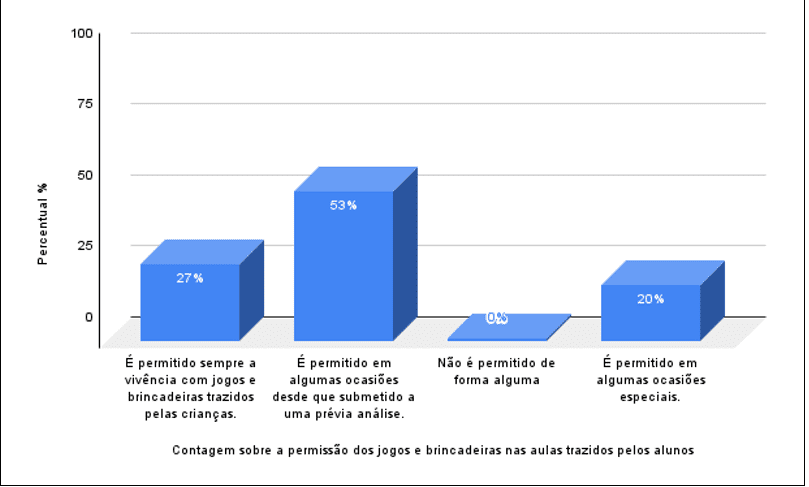
Alves et al (2015) also discusses the role of the educator in early childhood education and encourages and encourages all teachers to be more dedicated, committed, involved, creative, motivated and enthusiastic about their occupation and mission within education, talks again about the importance of understanding, knowing, perceiving and interpreting each student, that is, it is extremely important that the teacher manages to assimilate the play of his students, because through this analysis and observation he can also learn, because the educator in the classroom can break down the function of teaching and learning.
For the author, it was clear in his observations and corroborated with several authors that children do not arrive at the school environment destitute of experiences with games, but on the contrary, they have in their essence the game as an inexhaustible source of pleasure and contentment, therefore, the child can also pass on their knowledge and experiences to their mentor, thus making it possible to increase the collection of games and play (ALVES et al., 2015).
In his observations and research Marques (2017) emphasizes the importance of “free” games at opportune times within the school environment, playing is fundamental and must be encouraged and promoted daily, through the various games developed, there is a continuous improvement mainly in students with learning complications and behavioral disorders, highlights that the task is not easy, but it is not impossible, therefore, the importance of educators to see beyond the lines of the classroom, to have a broad vision, perceiving a potential in each student.
According to the studies carried out, it can be seen through the data inserted in graph 12 that deals with the autonomy of the teacher to propose activities of games and play in their classroom, therefore, the majority of educators, corresponding to 63%, declare that they have autonomy for the development of games and activities in their classroom. Another 31% responded that the school allows the development of activities, however, these activities have reservations imposed by the institution. Of those interviewed, 6% say that the school rarely allows the development of games and activities in their classrooms. And 0%, that is, no teacher surveyed declared that the school does not allow games and activities in the classroom in any way.
Graph 12 – Teacher autonomy to propose games and play activities in their classroom
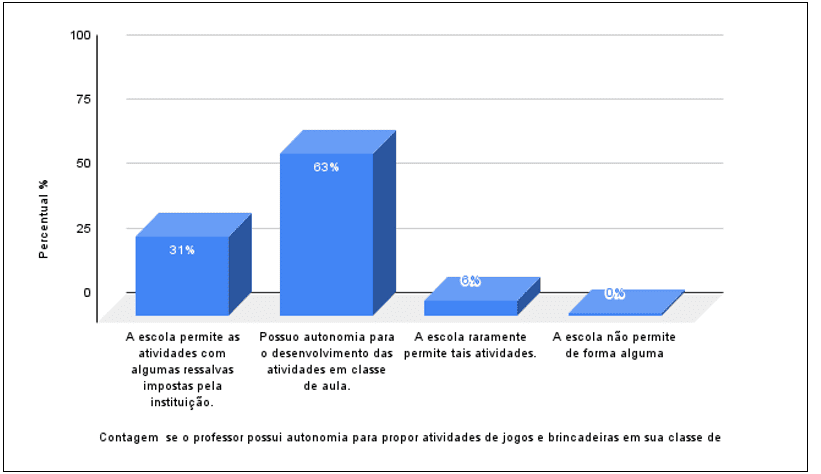
In the work developed by Marques (2017) he presents other games and games that present the intervention and mediation of educators in the classroom, games that stimulate the development of social, cognitive, motor and social skills, and as a result of the development of these capacities can expect from the children the unfolding of creativity, improvement of motor coordination, motor learning and motor skills, stimulation of logical reasoning, communication, autonomy and socialization, therefore, the teacher’s role is fundamental to mediate the activities developed, the teacher participates directly in the activities and is the starting point, the development point and the closing point.
Providing opportunities for play in school spaces, especially in Early Childhood Education, Navarro and Prodocimo (2012) does not reveal that the child should merely play without intention or without a mediator who makes their interference, it clarifies, therefore, that when the educator or mentor fails to make their interventions in the educational course, this principle is called “pedagogical abandonment”. Mainly in the context of play that education professionals reveal their role in the school context of mediator and agent of transformation.
He also argues that instead of dedicating himself to concepts, games and play that students already master, the educator must be ready for new knowledge, in a certain way it would advance the development, therefore, the importance of the teacher to develop with excellence his role of educator, mediator and agent of transformation (NAVARRO; PRODOCIMO, 2012).
… o educador pode ser considerado um dos melhores mediadores do desenvolvimento das crianças. As aprendizagens construídas na escola, muitas vezes, são as mais relevantes para a vida das pessoas. E, ainda, educadores escolares podem oferecer condições melhores de desenvolvimento aos seus educandos. Tais aprendizagens de âmbito escolar, além de oportunizar uma relação íntima com o saber, tem funções de socialização (SOUZA, 2008, p. 12).
The National Curriculum Framework for Early Childhood Education – RCNEI (BRAZIL, 1998) is a reference and points out about the attributions, duties, functions and obligations of teachers. According to recorded data from the RCNEI, teachers need to have perception and discernment regarding the evidence of the importance of games in the school context and how games are characterized as a fundamental element for children to be able to reformulate and establish levels and plans of knowledge, through constructive actions. , imaginary and authentic. Therefore, it is noticeable how important it is for teachers to recognize and put into practice recreational activities in the pedagogical context.
According to the results obtained in Table 3, below, it can be seen that the majority of the respondents, being 69 responses, consider through the opinions that the aspects that are developed in children through the activities of games and play inserted in the Teaching classes Fundamental are group interaction, that is, relationships and social interaction. In the background, the interviewees suggest that the ability to reason is the preponderant factor that is developed through games and play inserted in everyday classes. For another 37 teachers, they consider that the development of motor coordination is what is most developed through games and play carried out in the classroom in a pedagogical way.
Table 3 – Opinions regarding the aspects that are developed in children through the activities of games and play inserted in Elementary School classes:
| Opinions | Answers |
| Group interaction | 69 |
| Reasoning ability | 48 |
| Motor coordination | 37 |
| Creativity | 14 |
| Concentration | 14 |
| Heads up | 10 |
| Psychic development | 10 |
| Autonomy | 10 |
| Respect to the next | 10 |
Source: Prepared by the author (2021).
According to Souza (2018) the act of playing benefits and enriches the learning of elementary school children, playing is part of the individual’s life, playing is living in a world of fantasy, discoveries, imaginations and achievements. Playing can be characterized as one of the most instructive and constructive procedures of the pedagogical process, because through the games the child develops the intellectual, emotional and bodily aspects. Playing in its playful expression creates countless possibilities for development and learning, playing if you learn and learning if you play are associated aspects that must be taken into account by educators and parents.
Souza (2018) adds that through play and in the act of playing that the learning processes take place, children who play develop a potential to create new games, live the fantasy, discover new possibilities, explore and investigate, live in the imagination, develop diversities and experiences, they try to make exchanges, lend, share and with that they are more sociable and independent.
In graph 13, below, built from the data collected by the answers to the question: if teachers consider and are prepared to insert traditional games and play in their classes so that they are part of the teaching-learning process. It can be seen from the data obtained that 26% of those surveyed consider them prepared to develop such activities, however, they need recycling to be carried out with excellence. Another 28% of teachers consider it fully prepared to develop games and play activities. For 23% of the professors, they feel relatively prepared for the development of activities related to the teaching-learning process. Only 3% of the interviewees declare that they do not feel prepared in any way to include traditional games and play in their classes so that they are part of the teaching-learning process.
Graph 13 – It is considered that teachers are prepared to insert traditional games and play into their classes so that they are part of the teaching-learning process:
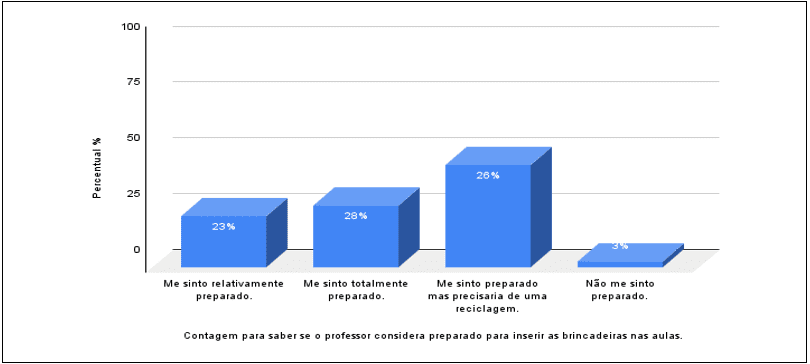
In the research and reflections of Marques (2017) it addresses the importance of games and play in the literacy process, learning and training of students. However, it pertinently reveals that teachers of elementary and early childhood education are not limited to teaching through the transfer of school contents, but that they have perception and discernment regarding the development of the psychological aspects of students to whom learning and knowledge are essential. assimilated. He emphasizes that games and play are strong allies in the learning and development process, because through playful activities, the environment and teaching become more pleasant, engaging, attractive and pleasurable.
Therefore, playing is one of the activities that have great relevance in the school context and needs to be integrated into the teaching process of schools, as well as teachers need to obtain such knowledge for the development and applicability in the classroom, allowing their students a connection between teaching and learning and between playing learning and learning by playing as a facilitating and transforming form of education. This mentioned knowledge should be encouraged from the preliminary academic training, offering the possibility of applying this learning and development moderating tool (MARQUES, 2017). The author also mentions that:
O brincar é de extrema importância no dia a dia das escolas, tornando o ambiente mais agradável, proporcionando momentos prazerosos e de muito aprendizado e cabe aos educadores fazerem uma reflexão crítica sobre o brincar em sala de aula, e o professor precisa ter acesso a esse conhecimento, sobre a utilização do lúdico para o ensino de seus alunos. Este conhecimento deve ser estimulado desde sua formação inicial, dando-lhe condição de utilização desse instrumento facilitador de aprendizagem (MARQUES, 2017, p. 40).
In this sense, Navarro and Prodocimo (2012) highlights the role of the education professional and presents that the educator can and should be the mediation agent that will provide their students with countless opportunities for creation, investigation, imagination, organization, guidance and experimentation, so that all these factors occur in their fullness, it is important for the professional to know about the environment, the materials available, the forms of organization and intervention, in addition to raising awareness about the importance of games for the formation and construction of knowledge on the part of their students. .
4. FINAL CONSIDERATIONS
The research found correlations between authors with regard to rescuing old games and play and how they can be effective in the physical, cognitive, social, affective and psychological development of elementary school children.
The aim of this study was to analyze the contributions of games and play experienced in the past so that they can favor the integral development of students from the 1st to the 5th year of elementary school in the municipal network of the city of Belo Horizonte. In this sense, the general objective of the work was answered during the development of the theoretical framework, where through literature and scientific basis added to field research, the importance of games and play for the integral development of elementary school students became clear.
In relation to the research problem, after analyzing the theoretical framework and field research where teachers identified and notoriously exposed forms and processes for the application of games and old play , corroborating with scholars about the developed theme, it was understood that there is an understanding about the importance of playing games.
It was found in the research that teachers have already worked with traditional games and play in everyday life, and it was observed that the majority (40% of respondents) regularly use games and play in their classes.
According to most respondents in this study, it is noted that most had experience in childhood with traditional games and play, but few use them assiduously, despite recognizing that they can be used in all subjects. They stated that the greatest benefits are related to group interaction, reasoning ability and concentration, partially confirming the hypothesis of this study. There is still a need for a broader understanding of the practice of games and play, covering aspects of development in its entirety, with teachers having more pedagogical intentionality in their planning in practice.
The results obtained in the study offer faculty, educational institutions and education professionals the possibility to examine and reconsider their conventional study plans and strategies so that they become more participatory, engaging and effective.
REFERENCES
ALVES, R. É brincando que se aprende. Páginas Abertas. v. 27, n. 10, p. 20-21, 2001.
ALVES, N. F.; LUCCAS, M. D.; ORLANDI, L.; LIMA, M. C.; LIMA, J. M. A brincadeira no contexto escolar: um recurso de socialização. Encontro Nacional de Ensino, Pesquisa e Extensão, Presidente Prudente, 19 a 22 out., 2015. Colloquium Humanarum, v. 12, n. Especial, 2015, p. 925-932. ISSN: 1809-8207. DOI: 10.5747/ch. 2015. v12. nesp. 000708.
ANDRÉ, M. E. D. A. produção acadêmica sobre formação de professores: um estudo comparativo das dissertações e teses defendidas nos anos 1990 e 2000. Revista Brasileira sobre Formação Docente, Belo Horizonte, v. 1, n. 1, p. 41-56, ago/dez. 2009.
BRASIL. Referencial Curricular Nacional para a Educação Infantil. Ministério da Educação e do Desporto: Brasília: MEC/SEF, v. 1, 1998.
BRASIL. Diretrizes Curriculares Nacionais Gerais da Educação Básica. Ministério da Educação. Secretária de Educação Básica. Diretoria de Currículos e Educação Integral. – Brasília: MEC, SEB, DICEI, 2013. 542p.
BRESCOVIT, L. E.; UTZIG, A. B. O desafio na atualidade do resgate de brinquedos e brincadeiras antigas na formação de crianças. Revista Científica FAEST: Faculdade de Educação de Tangará da Serra – MT www.uniserratga.com.br ISSN: 2319 – 0345, 2016.
BRUSTOLIN, D. S.; CONTE, E. T. Tirando do baú… as brincadeiras de outrora. Vamos reaprender a brincar. Ponta Grossa, Paraná. Universidade Estadual de Ponta Grossa – PDE, 2012.
CORDAZZO, Scheila Tatiana Duarte; VIEIRA, Mauro Luís. A brincadeira e suas implicações nos processos de aprendizagem e de desenvolvimento. Estud. pesqui. psicol., Rio de Janeiro, v. 7, n. 1, jun. 2007. Disponível em <http://pepsic.bvsalud.org/ scielo.php?script=sci_arttext&pid=S1808-42812007 000100009&lng=pt&nrm=iso>. Acesso em 31 jan. 2022.
DAOLIO, J. Da cultura do corpo. Campinas, SP: Papirus, 1995.
DUARTE, Bruna da Silva; BATISTA, Cleide Vitor Mussini. Desenvolvimento Infantil: Importância das Atividades Operacionais na Educação Infantil. A XVI Semana da Educação e o VI Simpósio de Pesquisa e Pós-Graduação em Educação. Universidade Estadual de Londrina, p. 292-306, 2015. ISBN 978-85-7846-319-9.
FANTACHOLI, Fabiane Das Neves. O Brincar na Educação Infantil: Jogos, Brinquedos e Brincadeiras: Um Olhar Psicopedagógico. Educação, 5ª ed., dez. 2011. Disponível em:<http://revista.fundacaoaprender.org.br/?p=78>. Acesso em: 02 jun. 2021.
FANTIN, M. No mundo da brincadeira: jogo, brincadeira e cultura na Educação Infantil. 2. ed. Florianópolis: Cidade Futura, 2000.
FARDIN, S. C. Resgate de brinquedos e brincadeiras antigas: um estudo com docentes dos anos iniciais de uma escola municipal de ensino fundamental de Passa Sete – RS. Santa Maria, Rio Grande do Sul, 2015.
GIL, A. C. Como elaborar projetos de pesquisa. 4ª edição. São Paulo: Atlas, 2002.
GIL, A. C. Métodos e técnicas de pesquisa social. 6. ed. – São Paulo: Atlas, 2008. ISBN 978-85-224-5142-5
GIL, A. C. Métodos e técnicas de pesquisa social. 5. Ed. São Paulo: Atlas, 1999.
KISHIMOTO, T. M. Jogo, brinquedo, brincadeira e a educação. 5 ed. São Paulo: Cortez, 2001.
LAKATOS, E. M.; MARCONI, M. A. Fundamentos de metodologia científica. – 5. ed. – São Paulo: Atlas 2003.
MARQUES, E. S. Brincar e aprender: qual o lugar da brincadeira no ensino fundamental? 42f.: Il. Trabalho de Conclusão de Curso (Graduação em Pedagogia) – Universidade Federal Fluminense, Instituto de Educação de Angra dos Reis, 2017.
MARQUES, L. S.; MARVILA, K. C.; VIERA, M. R.; CAMPOS, M. D. A importância do brincar na Educação Infantil. Revista Científica Multidisciplinar Núcleo do Conhecimento. Ano 05, Ed. 11, v. 08, p. 103-114. nov. 2020. ISSN: 2448-0959, Disponível em: <https://www.nucleodoconhecimento.com.br/educacao/ brincar-na-educacao>. Acesso em 28 dez. 2021.
MINAS GERAIS. Informação. Secretaria Municipal de Educação (SMED). Mensagem recebida por [email protected]. 07 de janeiro de 2022. Disponível em:< https://mail.google.com/mail/u/0/#inbox/QgrcJHrnxTJrgmxwCfMTCJ qtqDTLlcGbfJl>. Acesso em: 07 de janeiro de 2022. Acesso em 27 dez. 2021.
NAVARRO. M. S.; PRODOCIMO. E.; Brincar e mediação na escola. Rev. Bras. Ciênc. Esporte, Florianópolis, v. 34, n. 3, p. 633-648, jul/set. 2012.
PICCIONI, R. L.; MATA, A. REBRINCAR – Resgate de Jogos, Brinquedos e Brincadeiras Tradicionais. Programa de Desenvolvimento Educacional – PDE. UFPR, Curitiba- Paraná, 2007.
RIBAS, I. B.; PEREIRA, M. M. Valorizando a hora do recreio: Resgate histórico dos brinquedos e brincadeiras. Universidade Estadual de Ponta Grossa, Ponta Grossa, Paraná, PDE, 2012.
RODRIGUES, E. S.; SANTANA, J. M.; SANTOS, V. C. O resgate das brincadeiras populares na educação infantil. Aracaju-Sergipe, 2016. Disponível em:< https:// portal.fslf.edu.br/wp-content/uploads/2016/12/TCC_rica_Joseane_e_Vanuzia.pdf>. Acesso em 28 dez. 2021.
SANTOS, Márcia Elena Andrade; QUINTAO, Nayara Torres; ALMEIDA, Renata Xavier de. Avaliação dos marcos do desenvolvimento infantil segundo a estratégia da atenção integrada às doenças prevalentes na infância. Esc. Anna Nery [online], v.14, n.3, p.591-598, 2010. Disponível: < https://www.scielo.br/j/ean/a/3fGzpWQGjnR HPp7HQXH5fDJ/abstract/?lang=pt>. Acesso em: 08 dez. 2022.
SANTOS, R. Jogos Antigos X Brinquedos Eletrônicos: uma Perspectiva Da Atualidade. Monografia de Conclusão de Curso de Educação Física da Faculdade de Ciências Biológicas e de Saúde da Universidade Tuiuti do Paraná. Curitiba, PR: Tuiuti, 2012.
SILVA. C, R. Redescobrindo antigos brinquedos e brincadeiras -a realidade do faz de conta. Avesso avesso, Araçatuba, v.2, n.2., p. 9 -23, jun. 2004.
SILVA, Patrícia Fernanda Da. O uso das tecnologias digitais com crianças de 7 meses a 7 anos. Tese apresentada ao Programa de Pós-Graduação em Informática na Educação do Centro Interdisciplinar de Novas Tecnologias na Educação da Universidade Federal do Rio Grande do Sul como requisito para a obtenção do título de Doutor em Informática na Educação. 2017, 232p.
SOUZA, C. F. A importância do brincar e do aprender das crianças na Educação infantil. Faculdade de Rolim de Moura, Roraima, 2018. Disponível em:< https://facsaopaulo.edu.br/wp-content/uploads/sites/16/2018/05/ed1/3.pdf>. Acesso em 28 dez. 2021.
SOUZA, K. M. O papel do educador para o desenvolvimento afetivo-emocional do estudante. Dissertação (Mestrado), Faculdade de Educação, Programa de Pós-Graduação, Nível Mestrado, PUCRS, Porto Alegre, 2008, 195 p.
TEIXEIRA, H. C.; VOLPINI, M. N. A importância do brincar no contexto da educação infantil: creche e pré-escola. Bebedouro, São Paulo: Cadernos de Educação: Ensino e Sociedade, p. 76-88, 2014.
[1] Master’s student in Educational Sciences. Sports Training Specialist. Bachelor of Physical Education. Bachelor in Sports, Leisure, Promotions and Events Management. ORCID: 0000-0002-1724-0348.
[2] Advisor. ORCID: 0000-0002-5929-7289.
Sent: February, 2022.
Approved: February, 2022.















